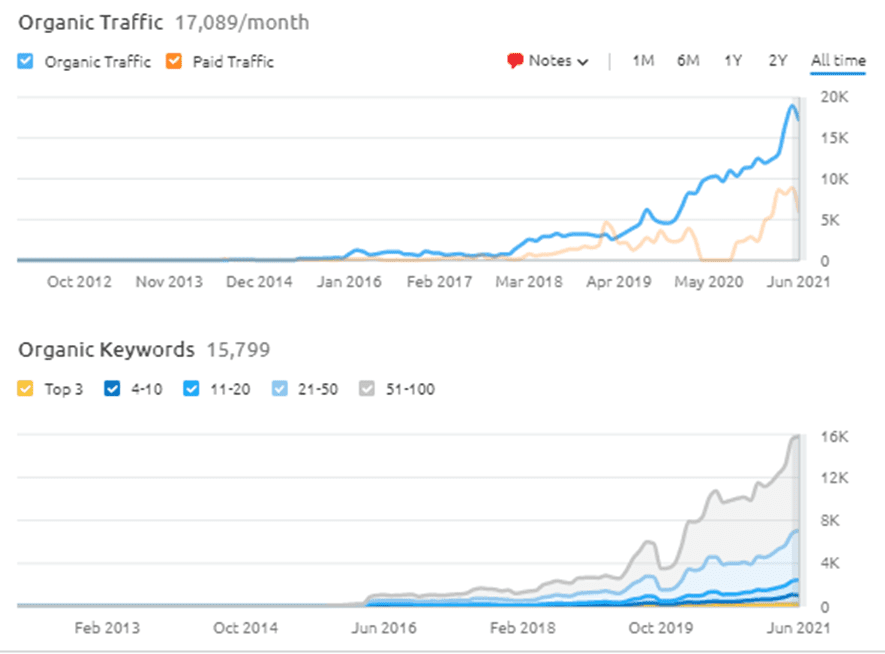If you are considering SEO copywriting services, here’s a brief overview to help you choose the best options for your needs and situation.
You can invest your time and money in developing a great website only to find that you aren’t generating the amount of business you expected. Unfortunately, the belief that a website by itself will magically generate more business is false. People searching for your products or services need to be able to easily find you. The key is SEO copywriting, a branch of digital marketing.
SEO copywriting is a set of techniques to make your website more search engine friendly with the goal of getting a higher ranking on free (organic) search results pages (organic search results appear in the middle of each page, with paid results appearing at the very top of the page).
Does your site come on the first page of results when you conduct an internet search for the specific keywords describing your products or services? If not, applying SEO (search engine optimization) copywriting techniques on a consistent basis will help you reach this goal.
Besides writing, other basic elements that play a role in search engine optimisation include:
- relevant and interesting content
- good website structure (including title tags and meta descriptions)
- links to your website from other sites (called backlinks) and a structured link-building process.
Here we’ll focus on SEO copywriting as the first step and having quality content that can help increase search rankings.
SEO copywriting services with the right copy for your site
Part of your site’s ranking is determined by how relevant your content is to what people are searching for. You need to know what terms people are searching for to determine the best keywords and phrases (also called search terms) to attract your target audience before you start your SEO writing.
You can use online keyword research tools such as Google Adwords Keyword Tool to find the keywords and phrases being used, and how often, to search for your product or service.
Let’s say your company sells laser printers. Here are the average monthly search volumes for Google searches in Australia for the following phrases.
- laser printer 74,000
- laser printers 33,100
- colour laser printer 9,990
- colour laser printers 3,600
These are only a few of many keywords and phrases used to search for laser printers, but they show us how to choose more effective keywords for your site with SEO web copywriting in mind. Keywords and phrases that are more exact, such as ‘laser printers Melbourne’ or ‘cheap laser printers Melbourne’ are known as long-tail keywords. Although the search volume for these isn’t as high as the main keywords, they are more specific and can help you generate more business.
Notice that there are more than double the number searches for the singular than plural forms of the phrases. This is important because most search engines, including Google, treat singular and plural words and phrases differently. When writing SEO content for your site, you will want to prioritise the terms laser printer and colour laser printer.
When analysing websites, spiders and robots look for the density of keywords and phrases on pages. The optimum keyword density depends on the search engine, but you’ll want a keyword density of around 2.0% (experts differ on this, so there’s no agreed number). If you use keywords too many times in your website content, it can be flagged by Google as ‘keyword stuffing’, resulting in a downgrade of keyword ranking. User experience is also an important consideration when creating SEO web copy, as this will affect your search rankings as well.
If you were writing a page describing your laser printers, you would want to repeat the phrase laser printer often enough using SEO copywriting so that it makes up around 2 per cent of the copy on the page. The challenge is to do this in a way that seems natural and doesn’t annoy your readers. There are many free keyword density tools online that you can find by doing an internet search using the phrase keyword density.
Another question is how you will present the content. SEO copywriting can be used to create a landing page (where you sell your product or service) or blog post where you share your knowledge with customers and prospects. While a landing page is good for getting enquiries and makings sales, a blog post gives you more scope for developing content around your keywords.
Include relevant and interesting content when SEO writing
Having relevant content for your site will help with search engine optimisation. If you are selling laser printers, you can have an article on your site titled Tips for Choosing the Best Colour Laser Printer for Your Needs. Not only will this give you the opportunity to include more keywords on your site with SEO copywriting, and improve your search engine rankings, it will build trust and show that you know your business.
Besides articles, blogs are a way to keep customers and prospects informed about the latest developments. For instance, you can write about the new model releases in your blog with the goal of ranking highly for search results for the latest models. Coming up with new blog ideas and checking the search statistics will give you good ideas of what to cover in your SEO copywriting.
While some writers talk about offering the best SEO copywriting services, it’s hard to claim this until you create content that generates results. A professional SEO copywriter is a person who writes copy that interests readers while ticking the boxes to help your web pages get found. While content marketers focus on the big picture, including social media, SEO web copywriting is more specialised.
SEO copywriting case study
Here’s an image that shows how we helped a financial services business boost their website visits with SEO copywriting. In 2018, they were getting around 2,000 organic (non-paid) visits to their site each month.

By creating relevant articles that are of interest to their customers and target market, we were able to increase their site visitors to nearly 18,000 per month by 2021. While there have been peaks and valleys along the journey, the overall trend for website visits has been going up. Much of this progress was the result of writing content combined with creating backlinks and improving the website structure.
Contact us on 1300 731 955 or use the contact form on this page to discuss SEO copywriting services and how we can help you boost the number of your website visitors.
Steps for SEO copywriting
Here are the steps we follow as part of SEO copywriting:
Understanding the audience
Before you start writing, you need to know who your audience is. This includes understanding their needs, what they are searching for, the keywords they use, and the type of content they prefer. Creating buyer personas can be an effective way to get into the mind of your ideal customer.
Conducting keyword research
We identify a list of key target keywords that your audience uses to search for your products or services. Using SEO tools like Google Keyword Planner, SEMrush, Ahrefs, or Moz, we find relevant keywords with good search volume and a level of competition you can realistically target.
Analysing search intent
Search intent is the reason behind a searcher’s query. It’s important to align your content with the intent, whether informational, navigational, commercial, or transactional. Make sure your content fulfills the user’s needs and answers their questions.
Crafting compelling headlines
Your headline should be enticing enough to make people want to read your content. Use your primary keyword in the headline and make it as engaging as possible while keeping it clear and relevant to the content.
Writing for the audience first
Your content should be written in a way that resonates with your audience. Always prioritize the reader’s experience over trying to game the search engine algorithms. The content should be engaging, informative, and provide value.
Using keywords strategically
Incorporate your chosen keywords naturally into your content, including the headline, subheadings, and body text. However, avoid keyword stuffing as it can harm readability and your search engine rankings.
Optimising meta descriptions
The meta description is the short text snippet that appears under your page’s URL in search engine results. Write a concise summary of your content and include your primary keyword. This doesn’t directly affect SEO rankings but can influence click-through rates.
Structuring content for SEO copywriting
Use headings and subheadings (H1, H2, H3, etc.) to structure your content. This makes it easier for readers to skim and for search engines to understand the hierarchy and relevance of your content.
Incorporating internal and external links
Link to other relevant pages on your website to keep readers engaged and to spread page authority throughout your site. Additionally, link to credible external sources to provide additional value and improve the trustworthiness of your content.
Including calls to action
We encourage your readers to act, whether it’s subscribing to a newsletter, downloading a guide, or contacting your business. Clear calls to action help turn traffic into conversions. If it’s an information piece of content, such as a blog, we can direct readers to service or product pages where we highlight features, benefits and next steps to make the purchase.
Editing and proofreading
We ensure your content is free of spelling and grammatical errors, as these can detract from your credibility and lower the user’s experience.
Using analytics to track performance
After your content is live, we use Google Analytics and other SEO measurement tools to track how your content is performing. We at metrics like page views, time on page, bounce rate, and conversions to understand the impact of the SEO copy.
Updating content regularly
SEO is not a one-time task. Search engine algorithms change, and content can become outdated. We keep the content fresh and relevant by updating it with current information, which can help maintain or improve your search engine rankings.
Although it’s not our main focus, we also consider other ranking factors, such as your site’s performance. If your site performance is slow, any SEO copywriting efforts will have limited effectiveness.


